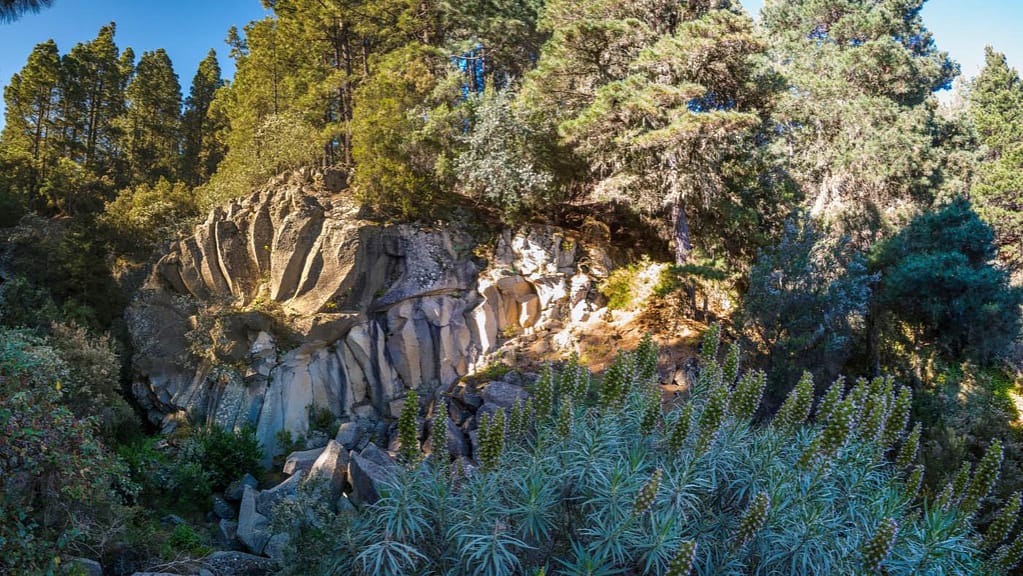Estimated reading time: 7 minutes
Piedra de la Rosa: Nature’s Rose Rock Formation in Tenerife North
Embark on a visual journey in Tenerife North as we unveil the mystique of Piedra de la Rosa—a captivating rose-inspired rock formation. Discover nature’s timeless beauty!
As I stood in front of the Piedra de la Rosa rock formation, I couldn’t help but feel amazed by its beauty.
This unique rock formation, located in North Tenerife, Spain, is shaped like a rose and is a result of a combination of processes that have taken place over millions of years. The Piedra de la Rosa is one of the most beautiful rock formations you can ever see on Earth.
The Piedra de la Rosa is a popular tourist destination, and many visitors come to see this stunning rock formation every year.
While it may not be the biggest or most famous rock formation in the world, it is undoubtedly one of the most unique and beautiful. The geological structure has a distinct rose shape, which is what makes it so special and attractive to visitors.
If you are planning a trip to Tenerife, I highly recommend visiting the Piedra de la Rosa. It is an excellent opportunity to witness the beauty of nature and appreciate the unique geological structures that our planet has to offer.
The Piedra de la Rosa is a perfect example of how nature can create something so beautiful and awe-inspiring.
Location of the Piedra de la Rosa Rock Formation
As I stand before the stunning geological structure of Piedra de la Rosa, I can’t help but feel awed by the natural beauty of this unspoiled marvel.
Piedra de la Rosa
Located in North Tenerife, one of the Canary Islands in Spain, Piedra de la Rosa is situated within the Parque Nacional del Teide, a UNESCO World Heritage Site.
The Parque Nacional del Teide is a protected area that encompasses the Teide Volcano, the highest peak in Spain, and its surrounding landscape. The park is home to a diverse range of flora and fauna, including over 168 species of plants that are endemic to the Canary Islands.
To reach Piedra de la Rosa, visitors must first navigate the winding roads that lead up to the park’s entrance. Once inside, the rock formation is easily accessible by foot, with a short hike leading to the site.
Visitors can also use maps and GPS devices to navigate the park’s many trails and scenic viewpoints.
The location of Piedra de la Rosa within the park is significant due to its unique geological features. The rock formation is made up of columnar basalts, a type of igneous rock that forms when lava cools and contracts, creating hexagonal columns.
Over time, erosion and weathering have caused the columns to take on the shape of a rose, with delicate “petals” that seem to defy gravity.
Geological Structure of the Piedra de la Rosa Rock Formation

As I stand before the Piedra de la Rosa, I am captivated by its unique geological structure. This basalt rock formation, located in Tenerife, Canary Islands, Spain, is shaped like a rose, with its petals delicately carved out of the rock.
Formation Process
The formation process of Piedra de la Rosa began millions of years ago when lava flowed out of the earth’s crust and cooled rapidly, forming basalt rock. Over time, the rock was subjected to various weathering processes, including wind and water erosion.
As the rock was eroded, it formed cracks and crevices, which eventually led to the formation of the rose-like shape we see today.
The cracks in the rock allowed for the formation of hexagonal prisms, which created the “organs” of the rose. Radial cracks formed “stone petals,” which were easily loosened, resulting in the formation of the rose.
The layers of the geological structure are visible, showing the different stages of the rock’s formation.
The basalt rock is dark in colour, and the layers have a rough texture, indicating the cooling process was rapid. The layers also show signs of weathering, with some parts of the rock being smoother than others.
Appearance of the “Stone of the Rose”

Piedra de la Rosa is a stunning geological structure located in a natural park in Spain. As I approach the formation, I am struck by its size and unique shape.
The rock appears to be made up of several layers, with each layer having a different colour and texture. The top layer is a light pink colour, which gives the rock its name, Piedra La Rosa, meaning “stone of the rose.”
Stone Petals
As I get closer to the rock, I notice that the top layer of the rock is shaped like petals, giving the rock formation a flower-like appearance. The petals are smooth and rounded, and they seem to be perfectly symmetrical.
The pink colour of the petals is striking against the backdrop of the green trees and blue sky.
The petals are not the only interesting feature of the rock formation. As I move around the rock, I notice that the layers underneath the pink layer are a darker shade of grey.
These layers are rougher in texture, and they appear to be made up of smaller stones that have been cemented together.
Split Layers
The layers of the rock formation are not uniform in thickness. Some layers are thicker than others, and some layers appear to be split in half, creating a jagged edge.
These split layers give the rock formation a unique and interesting appearance, as though it has been sliced open to reveal its inner layers.
History of the La Rosa de Piedra

Account
I have always been fascinated by the unique geological structures that can be found around the world.
One of the most interesting formations that I have had the pleasure of visiting is the Piedra de la Rosa in Tenerife, Spain. This formation is a beautiful sight to behold, and it has a rich history that is worth exploring.
The Piedra de la Rosa is a basalt rosette that is found in the Teide National Park in Tenerife. The formation is made up of columnar basalts, which were formed from volcanic activity in the area.
The rock formation appearance is named after its rose-like shape, and it is a popular tourist attraction in the area.
Attractions Tenerife

The history of the Piedra de la Rosa is not well documented, but it is believed that the formation was created millions of years ago during a volcanic eruption.
Over time, the lava cooled and hardened, forming the unique columnar basalt structure that we see today.
Despite the lack of historical documentation, the Piedra de la Rosa has a rich cultural significance for the people of Tenerife. The formation has been a source of inspiration for artists, writers, and poets for centuries.
It is also believed to have spiritual significance for some of the indigenous people of the area.
In recent years, the Piedra de la Rosa has become a popular destination for geologists and other scientists who are interested in studying the unique geological formations in the area.
The rock formation is also a popular spot for tourists who want to take in the beautiful scenery and learn more about the history of the area.
Plan Your Vacation with these useful links
- Find a flight
Kiwi.com – Helping you to find the cheapest airline tickets.
- Find an accommodation
Welcome to Tenerife. Enter your check-in date and choose from 9628 properties with Booking.com!
- Order taxi transfers from airports and hotels
Kiwi Taxi. Immediate departure, the driver meets you, pay online or in cash.
- Book Your Activities
Top sights you can’t miss in Tenerife! GetYourGuide.
- Rent a Car: Search, Compare, Save
Join now the many satisfied customers of Rentalcars.com – the leading car rental comparison website around the world. Only 3 steps separate you from “four wheels”!
- Ekta – is a new-generation insurance company that combines competitive prices with a high level of service.
You will receive your insurance policy by email within 2-3 minutes. There is a multilingual technical support chat 24/7.

